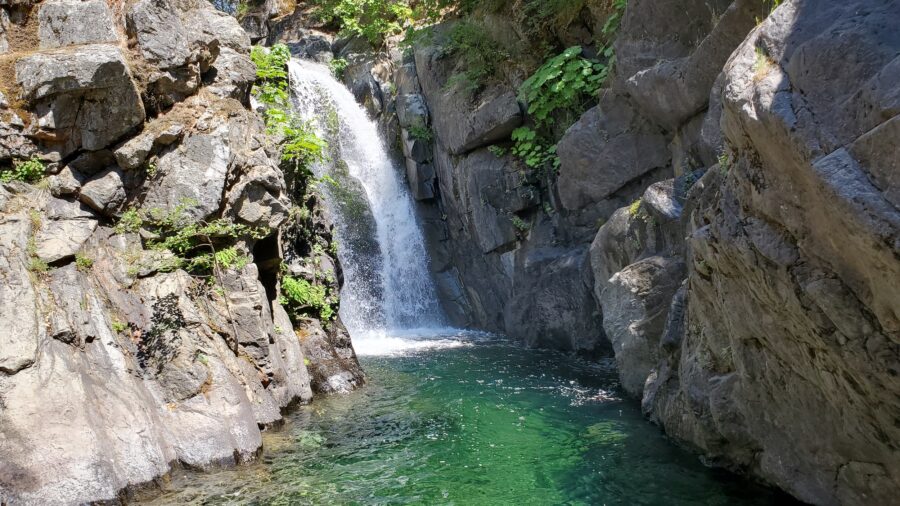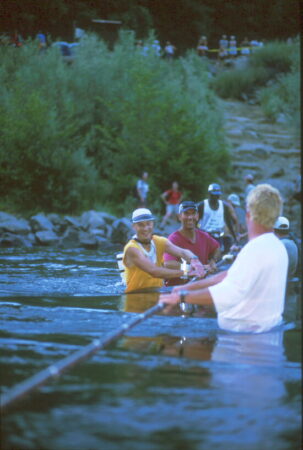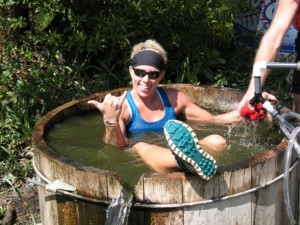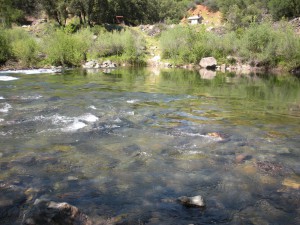Do you remember where you got drunk for the first time? At a party? A friend’s house? The prom? I was late to the partying scene compared to my friends as I was a goodie-goodie in high school: only one B, student body president, athlete … and it wasn’t until the end of my senior year when my friends finally got me to try enough alcohol to get drunk – oh how things have changed. The place? The 78 mile mark of the Western States Endurance Run course. Yep, the river crossing just below Ruck-A-Chucky rapid. I was a 125 pound runner so it only took a couple of Tom Collins. Probably not the smartest place to drink, but at least we were camping down there so there was no driving.
Crossing the Middle Fork of the American River at mile 78 of the WSER is perhaps the most exciting and classic feature of the course. During the race this year I’ll be looking forward to reaching this more than any other aid station short of the finish. Why? Aside from the nostalgia of my first buzz, it is cool, feels refreshing on tired, dirty legs, and it also marks the boundary of the last section of the race; after crossing the river there are only 22 fairly gentle miles to go. It’s also a lot of fun, plus you get to see your crew and walk/run up to Green Gate with them. But you have to do a little work to get there. I remember the first time I ran the race in 2001 the crossing seemed to take forever to get to. Leaving the crowds and noise of Foresthill, you immediately go downhill, but soon feel the remoteness of Cal St along the flattish single-track to Cal 2 (Peachstone). Then you finally start going down again and you get that tease when you get agonizingly close to the river. You can see and hear the river only to face an uphill walk on a dirt road AWAY from the river. Just plain cruel. But, eventually you emerge from Cal St, after 16 remote miles, to an army of volunteers and the cool refreshing water of the Middle Fork of the American River. If you’re one of the top 50 or so runners you get to cross in the daylight. The rest cross in the dark. I’ve been there as a runner in the daylight five times and as a pacer/crew in the night about 10, and I’ll admit, I like the daylight better.
If you are running the race this year, chances are the crossing will be a blur. You might not even notice the class VI Ruck-A-Chucky rapids 10 minutes before the crossing. But when you get there, try to remember to take a second to look at the aid station’s organizational structure. It’s amazing. The RD, Greg Soderlund, who has a myriad of details and logistics to deal with says the crossing “is very complicated and by far requires the most planning of any aid station. There are 23 tasks that must be accomplished to make it work.”
The 40-60 volunteers who are required to make this work are actually divided into three teams: the near or “dry” side which is a big aid station with food, drinks, and a weigh-in, the cable or boat crew, and the far or “wet” side which is also an aid station with food, drink, and drop bags so runners can change into dry shoes and socks. The crossing is open for about 11 hours not counting setup and breakdown.
The Near Side has been captained by Trish and Chuck Godtfredsen for the last four years. Like many of the 1500 volunteers who work the race, they are passionate about it and the role they play. I asked them why they keep coming back and this is what Chuck wrote:
“Being able to be a part of something that is bigger than us … For many people this is it, this is their moment, they come from all corners of the world to be there to achieve their goals, for many it is their first time, for some it is just another run, regardless of their motivation it is our desire to provide them the support both mentally and physically to get them to the finish line. We take great pride in the aid station.”
After you get weighed, fed, and watered on the Near Side by the Godtfredsens’ crew, you must cross the river – either by foot or by boat. In low water years the flow is lowered to a controlled rate of 350 cfs or less, by PG&E at the Oxbow Dam, 15 miles upstream. Of course, Greg has to make sure this is all coordinated. You ford the river holding onto a cable that is stretched across the river and manned by volunteers in wetsuits standing in the frigid water for hours. Since most of the runners cross in the dark, glo-sticks are placed on the river bottom and flashlights are shined down so we don’t get trapped in the rocks. In high water years professional boaters row us across.
When you finally get to the other side, you’re “escorted” up to the Far Side where Barb Frazier is your next host with the help of her unofficial co-captain, Bruce Linscott, who was 5th in the 1996 race. She has been there for 10 years, and is also very passionate about her role in the race. “We keep coming back because – plain and simple – it’s fun! I can’t say with certainty that I will never tire of the event and my responsibilities but it seems unlikely. The spot is awesome, just about the most beautiful on the course,” she writes. Many of Barb’s crew come down on Friday night and camp even though they don’t setup until later Saturday afternoon. They hang out at the crossing and like to, as she says, “speculate on which of our friends will do well or crash, whether the weather will be unbearable, where will we explore on Saturday a.m. before set-up, how will the top 5 shake out, will Twietmeyer and his fabulous legs make an appearance (okay – so maybe that’s just me)…”
Sorry, Barb, but Twiet won’t be crossing the river as the Pres doesn’t get dirty anymore. Maybe you can get AJW to show you his belly instead? Their major task is drop bags which must be picked up Friday afternoon at Squaw and then retrieved one at a time as runners get out of the river. Many runners change shoes and socks so Barb and Bruce have a great setup for helping us do that including tarps, chairs, and lights. But don’t plan on sitting too long as they are serious about “providing a kick in the butt” if you linger too long.
Together, these three teams cover only about 50 yards of the 100.2 mile WSER course, but their logistics coordination might rival the aid station complexity of many other entire races. Mind-blowing. Who would have thought that a remote high school drinking hangout could be transformed each year into a marvel of volunteer efficiency. Thank you Greg, Trish, Chuck, Barb, and Bruce for helping us get to Auburn. We’ll make you proud.
This is the 4th installment of the 2009 Western States Synchroblog Project. See what aid stations my other synchrobloggers are most looking forward to reaching.





Great post, LB. I stopped at the Near Side to repair myself in 2007 when things weren’t going my way. Even in my dazed state, I remember marveling at the logistics of that aid station (and at that point I was only seeing a third of it). I had a massage while my pacer ate Chinese food. It was like a trip to the day spa. When I reached the other side, I felt about as refreshed as one can feel at that point in a 100 miler. I never did get to thank the volunteers who helped me put myself back together. So thanks to the River Crossing crew, yo!
lc
@lowercase – Your pacer eating Chinese food reminds me of 2005 when my pacer enjoyed brownies at Brown’s Bar while I slumped over the aid table in a hypoglycemic state looking for coke and soup. Guess who that pacer was?
Dude, you have aged more than I have since 2002. Look at the rosy cheeks and the bright eyes. You are but a shell of your former self (SLF).
I’m also looking forward to this aid station in particular. My only only other time running was 2005, a snow year which necessitated rafts. While I’m looking forward to cooling down in the river, i worry that cramping might be a byproduct. Whatever may happen it will be great. The only thing the aid station needs is Col. Kurtz.
@SLF – I may have aged more but at least I’ve put on more weight.
I’ve never had a problem cramping in the river. You’re gonna have your electrolytes/hydration dialed.
Col Kurtz? You’re showing your age again.
Craig, Great piece of writing. I look forward to coming into the river crossing with you in June. See you in a few weeks.
pierre.
Crossing it on foot was definitely much better than on boat. Hope it happens this year, as I get my runner across in the middle of the night. Also hope you’ll be taking a nap by then:)
@Nathan – Good to hear from you Pierre. Hopefully we’ll crank out a 2:45 Cal St before crossing the river together.
@olga – Yeah, I agree that crossing in a boat is anticlimactic. But then again, how many races do you run in your life where you have to put on a life jacket? That’s pretty cool.
Great writeup Craig. Hope you are recovering from your WS training camp ok. The river crossing feels so good on tired legs and trashed quads. It’s not so great on blisters but I’ll take the cool water anyways. The volunteers are amazing, and they do a fantastic job. I feel bad rushing through and not sticking around to fully enjoy all their hard work. We were on a training run before the race in 07, and were down at the river cooling off. We saw a guy digging in the river bank, and then he let out a little shout. Turns out he was the cable crossing guy, and he was digging for the anchor point for the cable. We wasn’t sure he would be able to find it since he hadn’t seen it in a couple years. I think it was a boat year in 06. Anyways, just a story about one little (but big) part of the many things that have to happen for the river crossing to happen.
@Derek – Is this the Derek I just met in the canyons? Yeah, I crossed with blisters in ’01. My feet were just trashed. I did not change shoes and socks after the crossing because I didn’t want to see how bad they were.
Yep. Same Derek. Thanks for letting us crash your WS training camp for a few minutes.
Bili “Never met a brownie he didn’t like” Rubin!
It’s pretty titillating how an old high school drinking spot could transform into something so great. It just goes to show the powerful things we can accomplish when we use our creativity, and think outside of the box.
It’s not the resources that make something magnificent, it’s the mind behind the plan, and the motivation behind the action.